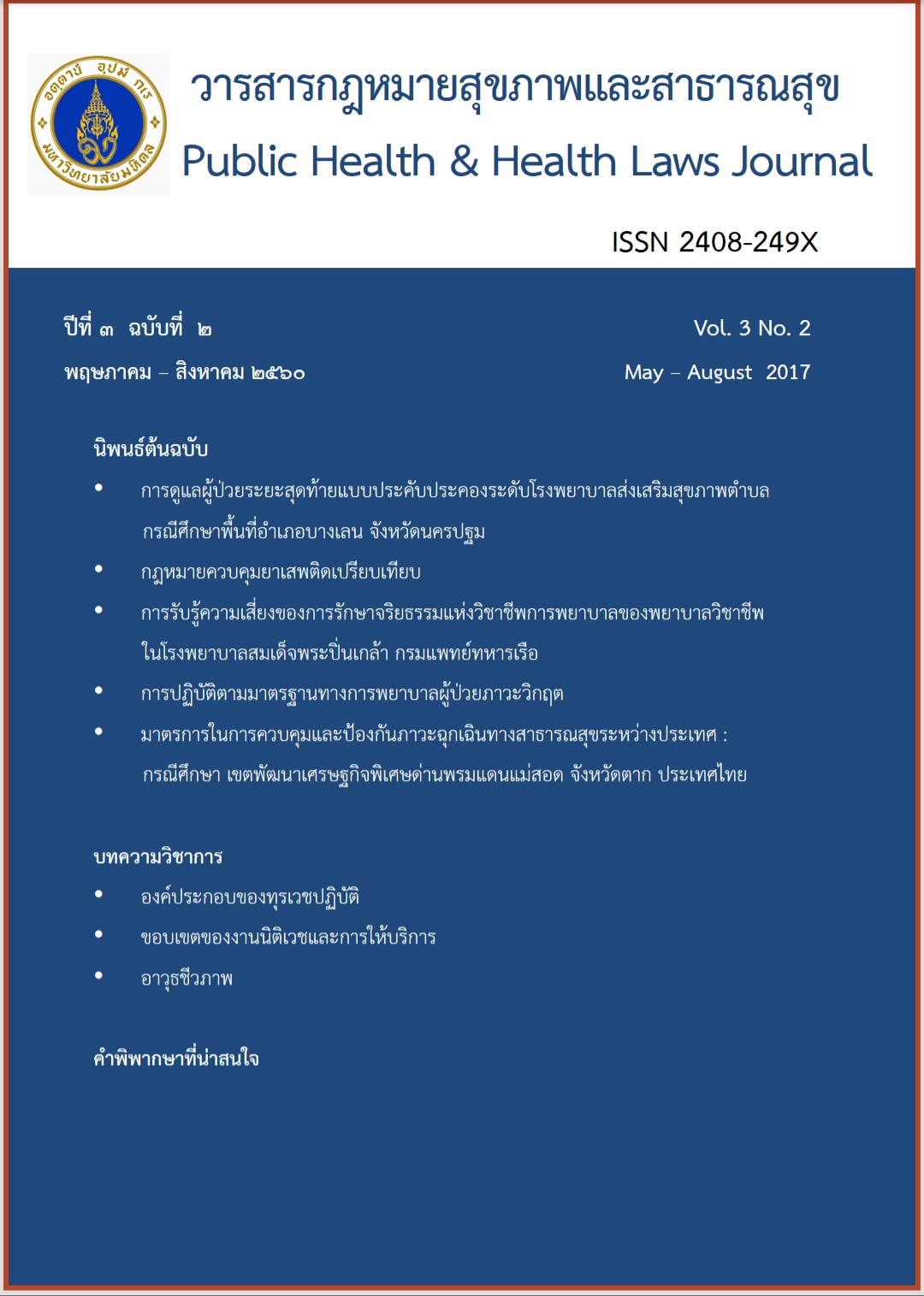Patient Care for the Terminally Ill Standard in the Hospital, Health District: A case study of Banglen District, Nakhon Pathom Province
Keywords:
palliative care, District Health Promotion Hospitals, Nakhon Pathom ProvinceAbstract
The objectives of this qualitative research were to examine patient care practices following palliative care guidelines, to investigate problems and obstacles in patient care practices following palliative care guidelines in district health promotion hospitals of Banglean District, Nakhon Pathom Province. The population was 66 health personnel. Instruments in the study included interviews and observation forms.
The findings revealed that the majority of participants were female, in the 35-44 age cohort with average age of 38.2 years old, holding a public health officer position (37.87%), and holding a bachelor’s degree (75.23%). Regarding the findings from observation on appropriate palliative care practices, it was found that overall practice was rated at a good level ( = 3.19; SD = 0.11). Two practices of palliative care were rated at a very good level from the observation: establishment of a good relationship with the patients and their relatives, and awareness of rights and confidentiality of the patients, and working ethics of the officers.
The study recommends that the allied-health officers in the district health promotion hospitals were still having difficulties in palliative care practices. Thus, clear role assignments and training sessions on the relevant laws for palliative care practices are suggested.
References
กิตติกร นิลมานัต (2555). การดูแลระยะสุดท้ายของชีวิต. กรุงเทพฯ : ชานเมืองการพิมพ์
ชลิยา วามะลุน และคณะ (2551). การเสริมสร้างความหวังและความรู้สึกที่มีคุณค่าในตนเองสำหรับผู้ป่วยมะเร็งที่มีภาวะซึมเศร้า กรณีศึกษา ศูนย์มะเร็ง อุบลราชธานี. มปท.
เดชา บัวเทศ (2553). สุขภาพพระสงฆ์ : รูปแบบการดูแลสุขภาพองค์รวมโดยการมีส่วนร่วมของชุมชนในภาคกลางตอนบน. มหาวิทยาลัยมหาสารคาม มปท.
ถนอมขวัญ ทวีบูรณ์ (2558). การดูแลผู้ป่วยระยะสุดท้าย ภาควิชาการพยาบาลรากฐาน” คณะพยาบาลศาสตร์ มหาวิทยาลัยมหิดล. สืบค้นเมื่อ 14 มิถุนายน 2558. Available at http://www. elearning.ns.mahidol.ac.th/Patients-with-end-stage/__5.html
ทรงคุณ จันทจร (2549). การวิจัยเชิงคุณภาพทางวัฒนธรรม”. กาฬสินธุ์ : สถาบันวิจัยศิลปะและวัฒนธรรมอีสาน มหาวิทยาลัยสารคาม, 2549.
นงค์รักษ์ สัจจานิจการ (2555). ผลการดูแลผู้ป่วยที่เจ็บป่วยด้วยโรคมะเร็งระยะสุดท้ายจากโรงพยาบาลสู่เครือข่ายชุมชน.โรงพยาบาลท่าวังผา อำเภอท่าวังผา จังหวัดน่าน. มปท.
นิรชา อัศวธีรากุล, ภัคคพงศ์ วงศ์คำ, ถิราพร พ่วงโพธิ์. (2556). “Palliative Care คู่มือการดูแลผู้ป่วยระยะสุดท้ายแบบประคับประคองสำหรับประชาชน”. กรุงเทพฯ : บริษัท สร้างสื่อ จำกัด, 2556.สืบค้นเมื่อ 12 มิถุนายน 2558 Available at http://www.slideshare.net/UtaiSukviwat sirikul/palliative-care-48737757
ปราณี อ่อนศรี (2557). “บทบาทพยาบาลกับการดูแลผู้ป่วยระยะสุดท้ายตามความเชื่อทางศาสนา.” วารสารพยาบาลทหารบก 15,2 (พ.ค.-ส.ค.) 39.
รัชฎาพร สีลา, สุกัญญา หังสพฤกษ์, สาคร ภูน้ำเย็น, ชาลีมาศ ตันสุเทพวีรวงศ์, จุฑาทิพย์ พิทักษ์, สายใจ วอนขอพร.(2558). คู่มือการดูแลผู้ป่วยระยะสุดท้ายแบบประคับประคองสำหรับทีมหมอประจำครอบครัว. นนทบุรี: สหมิตรพริ้นติ้งแอนด์พับลิสซิ่ง จำกัด, 2558.
วรรณภรณ์ พัฒนิบูลย์ และคณะ (2555).”การพัฒนารูปแบบการดูแลแบบประคับประคองสำหรับผู้ป่วยสูงอายุที่เจ็บป่วยเรื้อรังในระยะสุดท้าย หอผู้ป่วยอายุรกรรม 2 โรงพยาบาลร้อยเอ็ด”.วารสารสมาคมพยาบาลฯ สาขาภาคตะวันออกเฉียงเหนือ 30,3 (ก.ค.-ก.ย.) 74.
สมบัติ ตรีประเสริญสุข (2546). “ศาสตร์และศิลป์แห่งการดูแลผู้ป่วยเมื่อวาระสุดท้ายของชีวิต”. พิมพ์ครั้งที่ 2 . กรุงเทพฯ : หมอชาวบ้าน, 2546.
สุภางค์ จันทวานิช (2543). วิธีการวิจัยเชิงคุณภาพ. พิมพ์ครั้งที่ 9 . กรุงเทพฯ : สำนักพิมพ์แห่งจุฬาลงกรณ์มหาวิทยาลัย, 2543
Hermann, C.P. (2001) Spiritual needs of dying patients: A qualitative study. Oncology Nursing Forum 28(1) : 67-72.
WHO (2002).” WHO Definition of Palliative Care”. 2002 .สืบค้นเมื่อ 15 มิถุนายน 2558 Available at http:// www. who.int/cancer/palliative/definition/en/
Downloads
Published
How to Cite
Issue
Section
License
Disclaimer and Copyright Notice
The content and information presented in articles published in the Journal of Law and Public Health Policy represent the opinions and sole responsibility of the respective authors. The editorial board does not necessarily agree with or assume any responsibility for the views expressed.
All articles, data, content, images, and other materials published in the Journal of Law and Public Health Policy are the intellectual property of the journal. Any individual or organization wishing to reproduce, distribute, or otherwise use the entirety or any part of such materials must provide proper citation.





